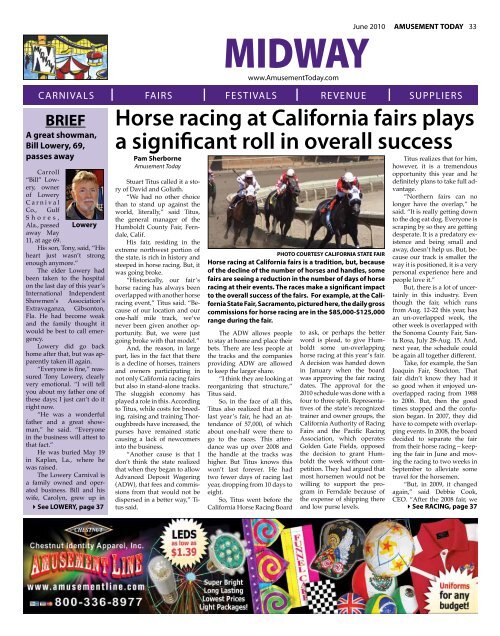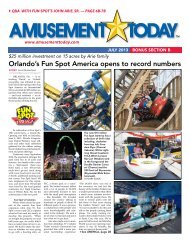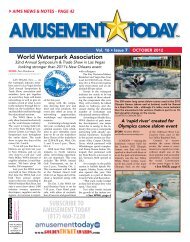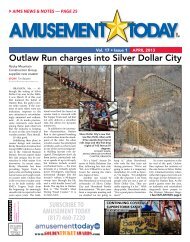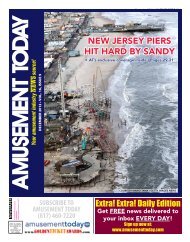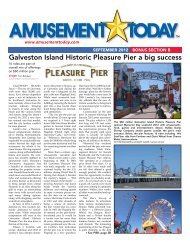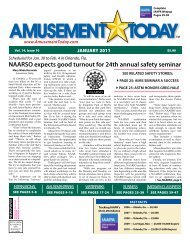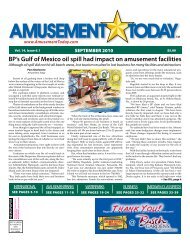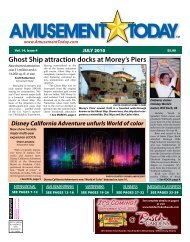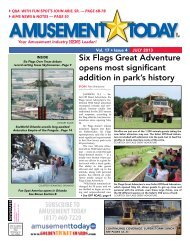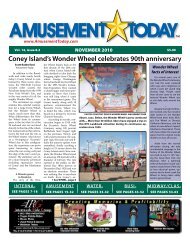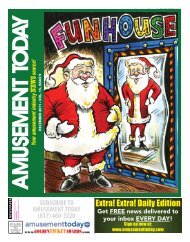June 2010 - Amusement Today
June 2010 - Amusement Today
June 2010 - Amusement Today
Create successful ePaper yourself
Turn your PDF publications into a flip-book with our unique Google optimized e-Paper software.
<strong>June</strong> <strong>2010</strong> AMUSEMENT TODAY 33<br />
MIDWAY<br />
www.<strong>Amusement</strong><strong>Today</strong>.com<br />
CARNIVALS<br />
BRIEF<br />
A great showman,<br />
Bill Lowery, 69,<br />
passes away<br />
Carroll<br />
“Bill” Lowery,<br />
owner<br />
of Lowery<br />
Carnival<br />
Co., Gulf<br />
Shores,<br />
Ala., passed<br />
away May<br />
11, at age 69.<br />
Lowery<br />
His son, Tony, said, “His<br />
heart just wasn’t strong<br />
enough anymore.”<br />
The elder Lowery had<br />
been taken to the hospital<br />
on the last day of this year’s<br />
International Independent<br />
Showmen’s Association’s<br />
Extravaganza, Gibsonton,<br />
Fla. He had become weak<br />
and the family thought it<br />
would be best to call emergency.<br />
Lowery did go back<br />
home after that, but was apparently<br />
taken ill again.<br />
“Everyone is fine,” reassured<br />
Tony Lowery, clearly<br />
very emotional. “I will tell<br />
you about my father one of<br />
these days; I just can’t do it<br />
right now.<br />
“He was a wonderful<br />
father and a great showman,”<br />
he said. “Everyone<br />
in the business will attest to<br />
that fact.”<br />
He was buried May 19<br />
in Kaplan, La., where he<br />
was raised.<br />
The Lowery Carnival is<br />
a family owned and operated<br />
business. Bill and his<br />
wife, Carolyn, grew up in<br />
4See LOWERY, page 37<br />
FAIRS FESTIVALS REVENUE<br />
SUPPLIERS<br />
Horse racing at California fairs plays<br />
a significant roll in overall success<br />
Pam Sherborne<br />
<strong>Amusement</strong> <strong>Today</strong><br />
Stuart Titus called it a story<br />
of David and Goliath.<br />
“We had no other choice<br />
than to stand up against the<br />
world, literally,” said Titus,<br />
the general manager of the<br />
Humboldt County Fair, Ferndale,<br />
Calif.<br />
His fair, residing in the<br />
extreme northwest portion of<br />
the state, is rich in history and<br />
steeped in horse racing. But, it<br />
was going broke.<br />
“Historically, our fair’s<br />
horse racing has always been<br />
overlapped with another horse<br />
racing event,” Titus said. “Because<br />
of our location and our<br />
one-half mile track, we’ve<br />
never been given another opportunity.<br />
But, we were just<br />
going broke with that model.”<br />
And, the reason, in large<br />
part, lies in the fact that there<br />
is a decline of horses, trainers<br />
and owners participating in<br />
not only California racing fairs<br />
but also in stand-alone tracks.<br />
The sluggish economy has<br />
played a role in this. According<br />
to Titus, while costs for breeding,<br />
raising and training Thoroughbreds<br />
have increased, the<br />
purses have remained static<br />
causing a lack of newcomers<br />
into the business.<br />
“Another cause is that I<br />
don’t think the state realized<br />
that when they began to allow<br />
Advanced Deposit Wagering<br />
(ADW), that fees and commissions<br />
from that would not be<br />
dispersed in a better way,” Titus<br />
said.<br />
PHOTO COURTESY CALIFORNIA STATE FAIR<br />
Horse racing at California fairs is a tradition, but, because<br />
of the decline of the number of horses and handles, some<br />
fairs are seeing a reduction in the number of days of horse<br />
racing at their events. The races make a significant impact<br />
to the overall success of the fairs. For example, at the California<br />
State Fair, Sacramento, pictured here, the daily gross<br />
commissions for horse racing are in the $85,000-$125,000<br />
range during the fair.<br />
The ADW allows people<br />
to stay at home and place their<br />
bets. There are less people at<br />
the tracks and the companies<br />
providing ADW are allowed<br />
to keep the larger share.<br />
“I think they are looking at<br />
reorganizing that structure,”<br />
Titus said.<br />
So, in the face of all this,<br />
Titus also realized that at his<br />
last year’s fair, he had an attendance<br />
of 57,000, of which<br />
about one-half were there to<br />
go to the races. This attendance<br />
was up over 2008 and<br />
the handle at the tracks was<br />
higher. But Titus knows this<br />
won’t last forever. He had<br />
two fewer days of racing last<br />
year, dropping from 10 days to<br />
eight.<br />
So, Titus went before the<br />
California Horse Racing Board<br />
to ask, or perhaps the better<br />
word is plead, to give Humboldt<br />
some un-overlapping<br />
horse racing at this year’s fair.<br />
A decision was handed down<br />
in January when the board<br />
was approving the fair racing<br />
dates. The approval for the<br />
<strong>2010</strong> schedule was done with a<br />
four to three split. Representatives<br />
of the state’s recognized<br />
trainer and owner groups, the<br />
California Authority of Racing<br />
Fairs and the Pacific Racing<br />
Association, which operates<br />
Golden Gate Fields, opposed<br />
the decision to grant Humboldt<br />
the week without competition.<br />
They had argued that<br />
most horsemen would not be<br />
willing to support the program<br />
in Ferndale because of<br />
the expense of shipping there<br />
and low purse levels.<br />
Titus realizes that for him,<br />
however, it is a tremendous<br />
opportunity this year and he<br />
definitely plans to take full advantage.<br />
“Northern fairs can no<br />
longer have the overlap,” he<br />
said. “It is really getting down<br />
to the dog eat dog. Everyone is<br />
scraping by so they are getting<br />
desperate. It is a predatory existence<br />
and being small and<br />
away, doesn’t help us. But, because<br />
our track is smaller the<br />
way it is positioned, it is a very<br />
personal experience here and<br />
people love it.”<br />
But, there is a lot of uncertainly<br />
in this industry. Even<br />
though the fair, which runs<br />
from Aug. 12-22 this year, has<br />
an un-overlapped week, the<br />
other week is overlapped with<br />
the Sonoma County Fair, Santa<br />
Rosa, July 28-Aug. 15. And,<br />
next year, the schedule could<br />
be again all together different.<br />
Take, for example, the San<br />
Joaquin Fair, Stockton. That<br />
fair didn’t know they had it<br />
so good when it enjoyed unoverlapped<br />
racing from 1988<br />
to 2006. But, then the good<br />
times stopped and the confusion<br />
began. In 2007, they did<br />
have to compete with overlapping<br />
events. In 2008, the board<br />
decided to separate the fair<br />
from their horse racing – keeping<br />
the fair in <strong>June</strong> and moving<br />
the racing to two weeks in<br />
September to alleviate some<br />
travel for the horsemen.<br />
“But, in 2009, it changed<br />
again,” said Debbie Cook,<br />
CEO. “After the 2008 fair, we<br />
4See RACING, page 37


